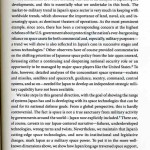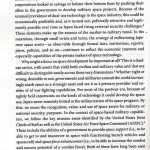mytest






![]()

UPDATES ON TWITTER: arudoudebito
DEBITO.ORG PODCASTS on iTunes, subscribe free
Hi Blog. Here are some excepts of a new book out from Stanford University Press on Japan’s space policy. “In Defense of Japan: From the Market to the Military in Space Policy” by Pekkanen and Kallender-Umezu. A complete tangent to what we do here at Debito.org, the book deserves an audience (reviewers have been a bit chary) given the subject matter: how easy it would be for Japan to become not only a nuclear power, but a military superpower in space should the situation in Asian geopolitics grow ugly. I happen to know one author (Paul, who gave me a copy) and the spouse of the other (Saadia, whose husband hosted me for a speech at UW years ago), and am happy to do them a favor and offer a little exposure here.
I haven’t read the book yet (received it Saturday, only gave it a thumb-through), but others might want to. Cover, ISBN, blurbs, and scans of the first three pages follow. Arudou Debito in Sapporo








4 comments on “New Book: “In Defense of Japan: From the Market to the Military in Space Policy” by Pekkanen and Kallender-Umezu”
Debito,
Thank you very much. What is astonishing is that the NHK has actually gone public (last week with a special on Saturday night) with old news, in that Japan was considering a bomb program. Why is this important? Well, it broke the unofficial media taboo that Japan is a virtual nuclear weapons state. There were some conceits, especially the point about the shock and surprise that Japan can quickly and easily go nuclear. But the narrative did break through into the official state media some of the reality of Japan’s nuclear and space program.
The actual investigation into whether or not Japan should go nuclear (not IF it could go nuclear) in 1968-9 is OLD news. But with the state/corporate media, all sorts of censorship, deliberately, or by default, i.e. ignoring it claiming it “isn’t news” is possible, so that NHK was able to repackage old news as new news.
What NHK did however, was to show the reality of Japan’s technological development in terms of its nuclear industry as a recessed deterrent. Japan has the ability, but keeps the shotgun under the counter, instead of wearing its gun in a holster.
Japan’s bomb making ability has increased incredibly since then, in fact Japan’s nuclear industry is geared to producing great quantities of supergrade plutonium.
It is absolutely no coincidence whatever that Japan decided to industrialize it space industry in 1969. The investigation into Japan going nuclear came the same year. Both were a reaction to the fact that China went from producing a relatively primitive A-bomb to a weaponizable H-bomb in 22 months.
Japan actually already had sold-fueled rocket technology that was considered weaponizable in the late 1960s. To understand the full argument about why Japan industrialized its space program please read the book.
To get more insight on Japan’s military space program, please take a look at my blog!
http://milspacejapan.blogspot.com/
Kind regards,
Paul (and Saadia)
Thank you for the recommendation!
Japan and aero-spacial are two of my favourite interests, it will be nice to read something about them combined. 🙂
Do you know if there the possibility that the book will be published in the European Union and maybe even in Italy specifically?
Abroad shipping from on-line purchases are always a little troublesome.
Thank you.
Actually quite terrifying stuff.
Foreign Affairs reviews Paul’s Kallender-Umezu’s book:
http://www.foreignaffairs.com/articles/67195/saadia-pekkanenpaul-kallender-umezu/in-defense-of-japan-from-the-market-to-the-military-in-space-pol
The bottom line of this book is clear enough: Japan’s capabilities are widely underestimated, all the more so in space.
AUTHOR
Saadia Pekkanen,Paul Kallender-Umezu
PUBLISHER
Stanford University Press
YEAR
2010
PAGES
408 pp.
ISBN
080470063X
PRICE
$55.00
In a shift little noticed outside professional military circles, in the last decade Japan has quietly developed a suite of cutting-edge military space technologies — rockets, satellites, and spacecraft — that were originally designed for commercial applications. The subject of this book is highly technical: the list of acronyms is 14 pages long, and some passages are hard going for a nonspecialist. But the bottom line is clear enough: Japan’s capabilities are widely underestimated, all the more so in space. The strategic logic for Japan’s space program is obvious, with a growing naval, space, and nuclear power across the East China Sea and a second nuclear power even closer, on the Korean Peninsula. The emphasis of In Defense of Japan, however, is on the industries that pushed military applications when they could not make money from commercial projects. Today, in addition to ballistic missile defense capabilities developed in cooperation with the United States, Japan is working on reusable launch vehicles (that is, space planes); satellites that detect missiles and help with navigation, communication, and targeting; warhead reentry technologies that can advance the use of missiles in warfare; unmanned aerial vehicles; and technologies for “space situational awareness,” which reveal a concern about possible future conflict in space. It is too soon to count Japan out in the arms race in Asia.
ENDS